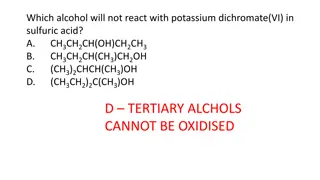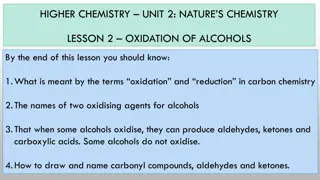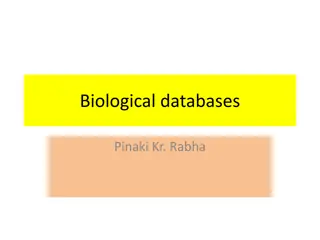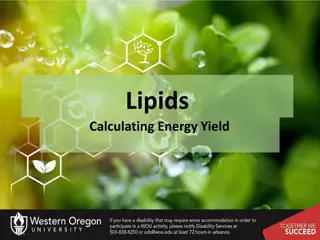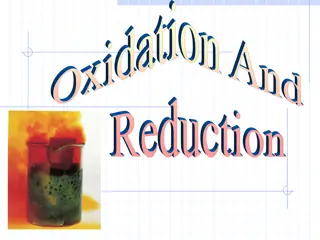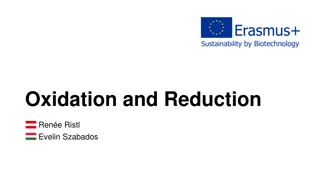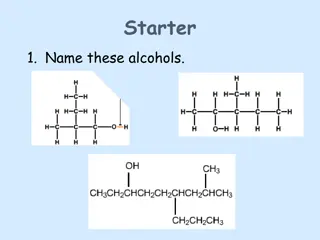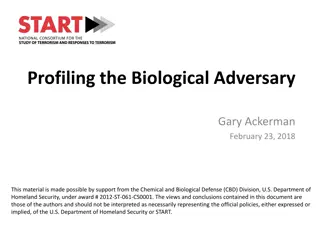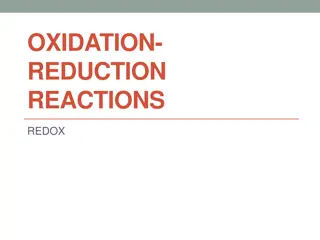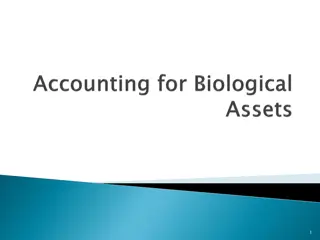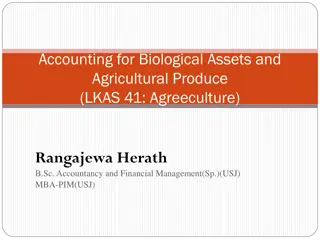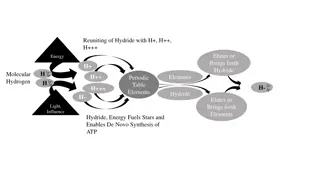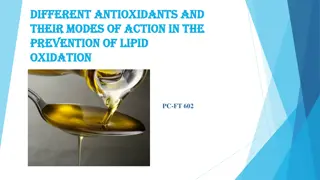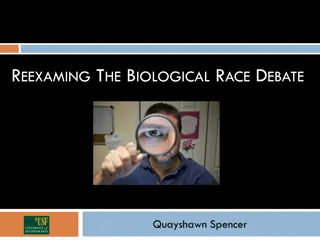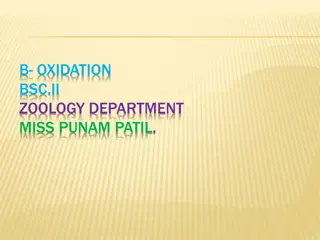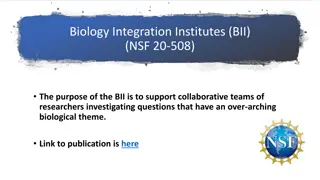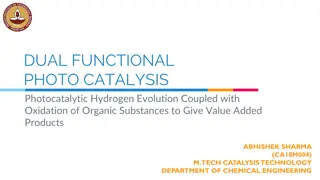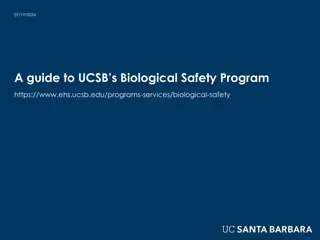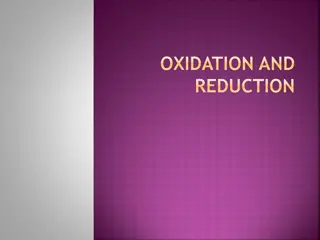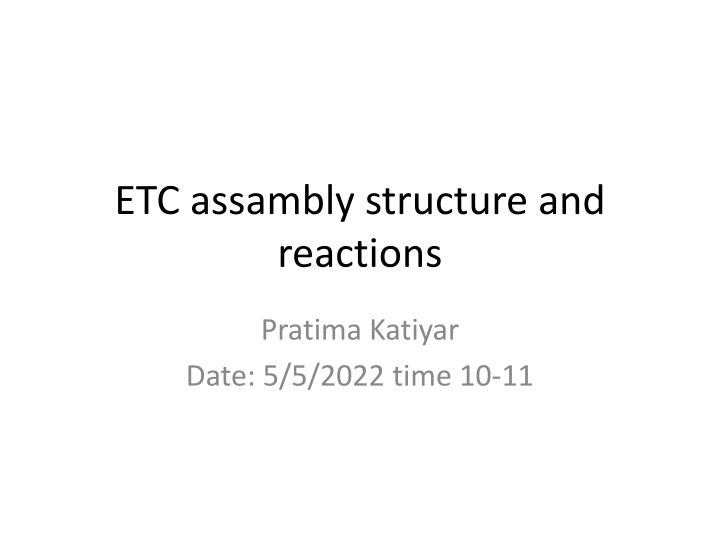
Flavoproteins and Dehydrogenases in Biochemical Reactions
Explore the role of flavoproteins and dehydrogenases in biochemical reactions. Flavoproteins containing FMN or FAD prosthetic groups play essential roles in enzymatic reactions, while dehydrogenases transfer hydrogen in oxidation-reduction reactions. Learn about the significance of NAD and NADP coenzymes, the vitamin riboflavin, and the metabolic pathways in which these enzymes operate.
Uploaded on | 1 Views
Download Presentation

Please find below an Image/Link to download the presentation.
The content on the website is provided AS IS for your information and personal use only. It may not be sold, licensed, or shared on other websites without obtaining consent from the author. If you encounter any issues during the download, it is possible that the publisher has removed the file from their server.
You are allowed to download the files provided on this website for personal or commercial use, subject to the condition that they are used lawfully. All files are the property of their respective owners.
The content on the website is provided AS IS for your information and personal use only. It may not be sold, licensed, or shared on other websites without obtaining consent from the author.
E N D
Presentation Transcript
ETC assambly structure and reactions Pratima Katiyar Date: 5/5/2022 time 10-11
Flavoproteins Flavoprotein enzymes contain flavin mononucleotide (FMN) or flavin adeninedinucleotide (FAD) as prosthetic groups. FMN and FAD are formed in the bodyfrom the vitamin riboflavin. FMN and FAD are usually tightly but notcovalently bound to their respective apoenzyme proteins. Metalloflavoproteins contain one or more metals as essential cofactors. Examples of flavoprotein enzymes include L-amino acid oxidase, an FMN-linked enzyme found in kidneywith general specificity for the oxidative deamination of the naturally occurringL- amino acids.
Dehydrogenases cannot use oxygen as a hydrogen acceptor There are a large number of enzymes in this class. They perform two main functions: 1. Transfer of hydrogen from one substrate to another in a coupled oxidationreduction reaction. These dehydrogenases are specific for their substrates but often utilize common coenzymes or hydrogen carriers, eg, NAD+ (Figure 9.1). Since the reactions are reversible, these properties enable reducing equivalents to be freely transferred within the cell. This type of reaction, which enables one substrate to be oxidized at the expense of another, is particularly useful in enabling oxidative processes to occur in the absence of oxygen, such as during the anaerobic phase of glycolysis. NAD+ + AH2 NADH + H+ + A Fig. 9.1: NAD acting as a hydrogen carrier in the dehydrogenase reaction. 2. As components in the respiratory chain of electron transport from substrate to oxygen
dehydrogenases depend on Nicotinamide Coenzymes These dehydrogenases use nicotinamide adenine dinucleotide (NAD+) or nicotinamide adenine dinucleotide phosphate (NADP+) or both and are formed in the body from the vitamin niacin. These coenzymes are reduced by the specific substrate of the dehydrogenase and reoxidized by a suitable electron acceptor. They may freely and reversibly dissociate from their respective apoenzymes. Generally, NAD-linked dehydrogenases catalyze oxidoreduction reactions in the oxidative pathways of metabolism, particularly in glycolysis, in the citric acid cycle, and in the respiratory chain of mitochondria. NADP-linked dehydrogenases are found characteristically in reductive syntheses, as in theextramitochondrial pathway of fatty acid synthesis and steroid synthesis and also in the pentose phosphate pathway.
dehydrogenases depend on Riboflavin The flavin groups associated with these dehydrogenases are similar to FMN and FAD occurring in oxidases. They are generally more tightly bound to their apoenzymes than are the nicotinamide coenzymes. Most of the riboflavin-linked dehydrogenases are concerned with electron transport in (or to) the respiratory chain. NADH dehydrogenase acts as a carrier of electrons between NADH and the components of higher redox potential. Other dehydrogenases such as succinate dehydrogenase, acyl-CoA dehydrogenase, and mitochondrial glycerol- 3-phosphate dehydrogenase transfer reducing equivalents directly from the substrate to the respiratory chain. Another role of the flavin-dependent dehydrogenases is in the dehydrogenation of reduced lipoate, an intermediate inthe oxidative decarboxylation of pyruvate and -ketoglutarate.
Ubiquinone or Q (coenzyme Q) Coenzyme Q links the flavoproteins to cytochrome b, the member of the cytochrome chain of lowest redox potential. Q exists in the oxidized quinoneor reduced quinol form under aerobic or anaerobic conditions, respectively. The structure of Q is very similar to that of vitamin K and vitamin E and of plastoquinone, found in chloroplasts. Q acts as a mobile component of the respiratory chain that collects reducing equivalents from the more fixed flavoprotein complexes and passes them on to the cytochromes. An additional component is the iron-sulfur protein (FeS; nonheme iron). It is associated with the flavoproteins (metalloflavoproteins) and with cytochrome b. The sulfur andiron are thought to take part in the oxidoreduction mechanism between flavin and Q, which involves only a single e-change, the iron atom undergoing oxidoreduction between Fe2+ and Fe3+.
The respiratory chain provides most of the energy captured during catabolism ADP captures, in the form of high-energy phosphate, a significant proportion of the free energy released by catabolic processes. The resulting ATP has been called the energy currency of the cell because it passes on this free energy to drive those processes requiring energy. There is a net direct capture of two highenergy phosphate groups in the glycolytic reactions, equivalent to approximately 103.2 kJ/mol of glucose. (In vivo, G for the synthesis of ATP from ADP has been calculated as approximately 51.6 kJ/mol. (It is greater than G0' for thehydrolysis of ATP, which is obtained under standard concentrations of 1.0 mol/L.) Since 1 mol of glucose yields approximately 2870 kJ on complete combustion, the energy captured by phosphorylation in glycolysis is small. Two more high-energy phosphates per mole of glucose are captured in the citric acid cycle during the conversion of succinyl CoA to succinate
P:O ratio All of these phosphorylations occur at the substrate level. When substrates are oxidized via an NAD-linked dehydrogenase and the respiratory chain, approximately 3 mol of inorganic phosphate are incorporated into 3 mol of ADP to form 3 mol of ATP per half mol of O2 consumed; ie, the P:O ratio = 3. Onthe other hand, when a substrate is oxidized via a flavoprotein- linked dehydrogenase, only 2 mol of ATP are formed; ie, P:O = 2. These reactions areknown as oxidative phosphorylation at the respiratory chain level. Such dehydrogenations plus phosphorylations at the substrate level can now account for 68% of the free energy resulting from the combustion of glucose, captured in the form of high-energy phosphate. It is evident that the respiratory chain is responsible for a large proportion of total ATP formation.
Inhibitors/poisions of Respiratory chain They may be classified as inhibitors of the respiratory chain, inhibitors of oxidative phosphorylation, and uncouplers of oxidative phosphorylation. Barbiturates such as amobarbital inhibit NAD linked dehydrogenases by blocking the transfer from FeS to Q. At sufficient dosage, they are fatal in vivo. Antimycin A and dimercaprol inhibit the respiratory chain between cytochrome b and cytochrome c. The classic poisons H2S, carbon monoxide, and cyanide inhibit cytochrome oxidase and can therefore totally arrest respiration. Malonate is a competitive inhibitor of succinate dehydrogenase. Atractyloside inhibits oxidative phosphorylation byinhibiting the transporter of ADP into and ATP out of the mitochondrion.
Reference Roskoski, Robert, Blue Ridge Institute for medical Research, north carolina. U. Satyanarayana, Biochemistry

